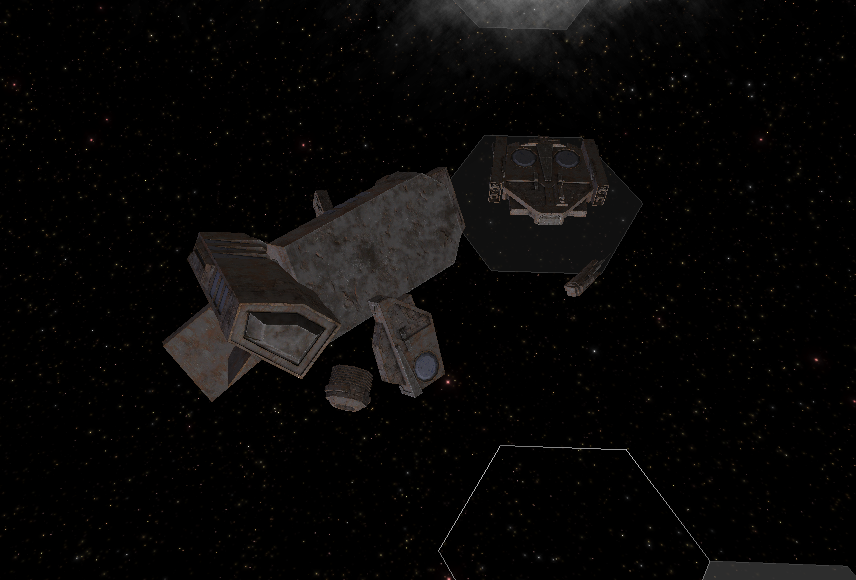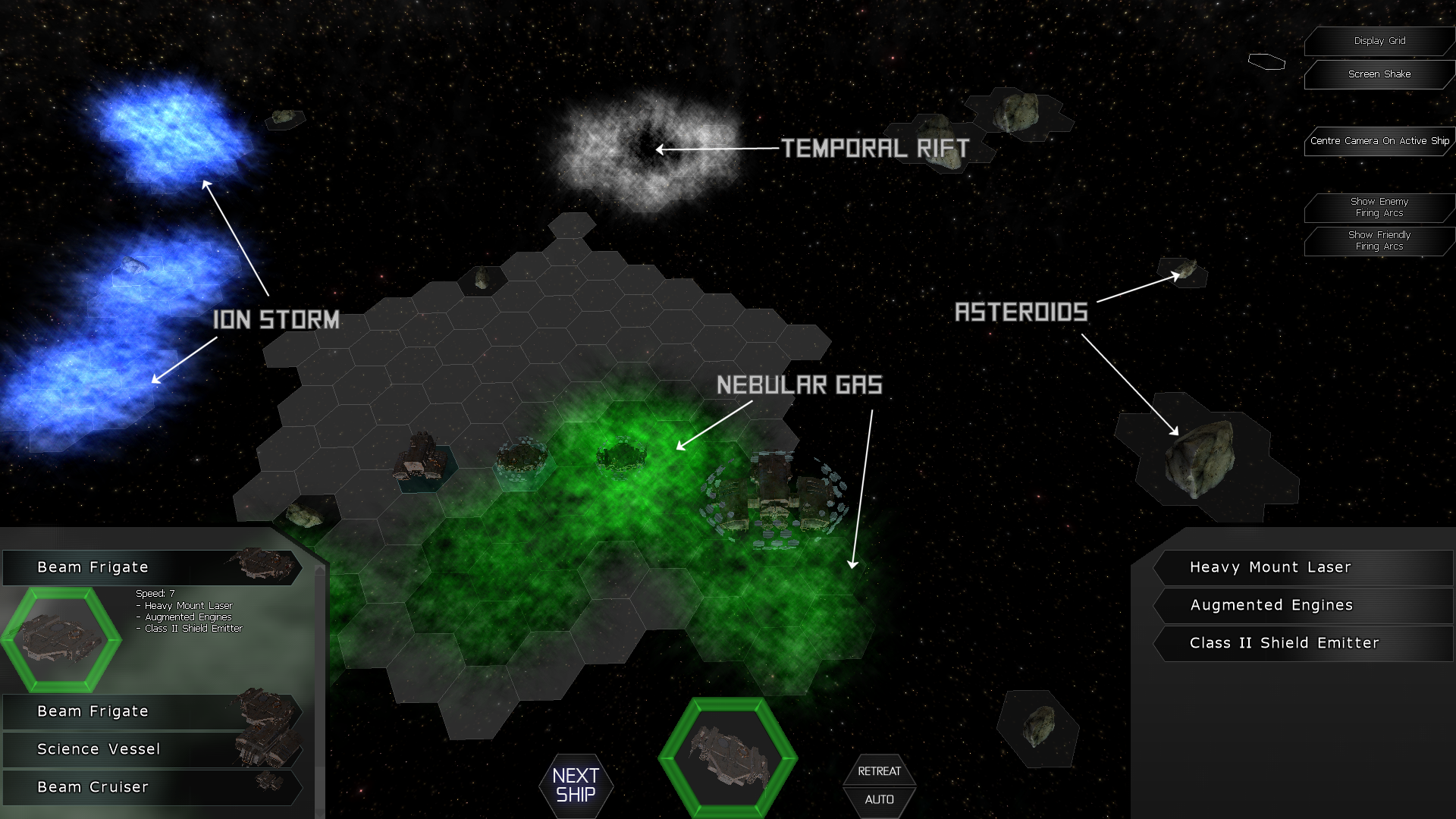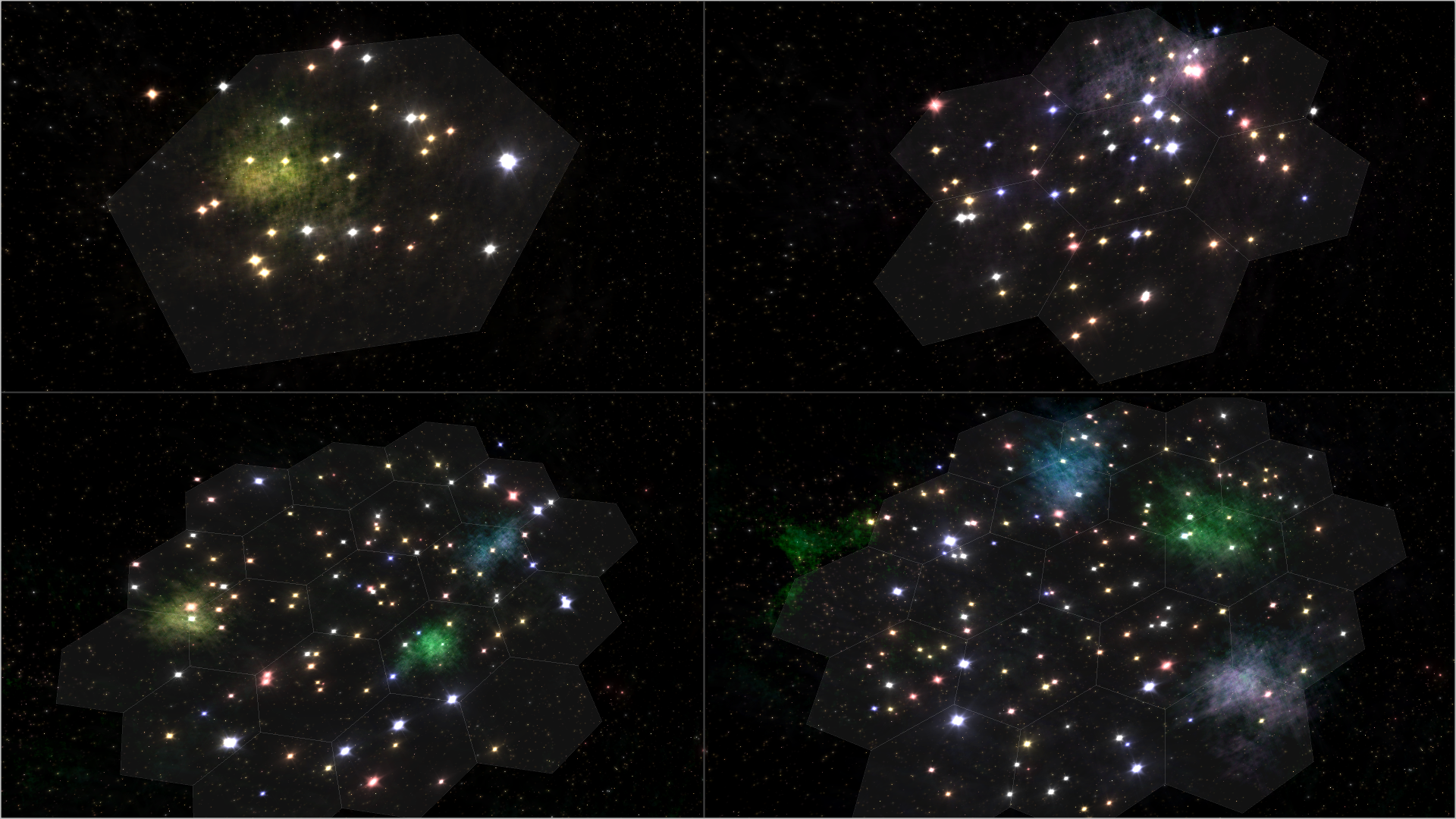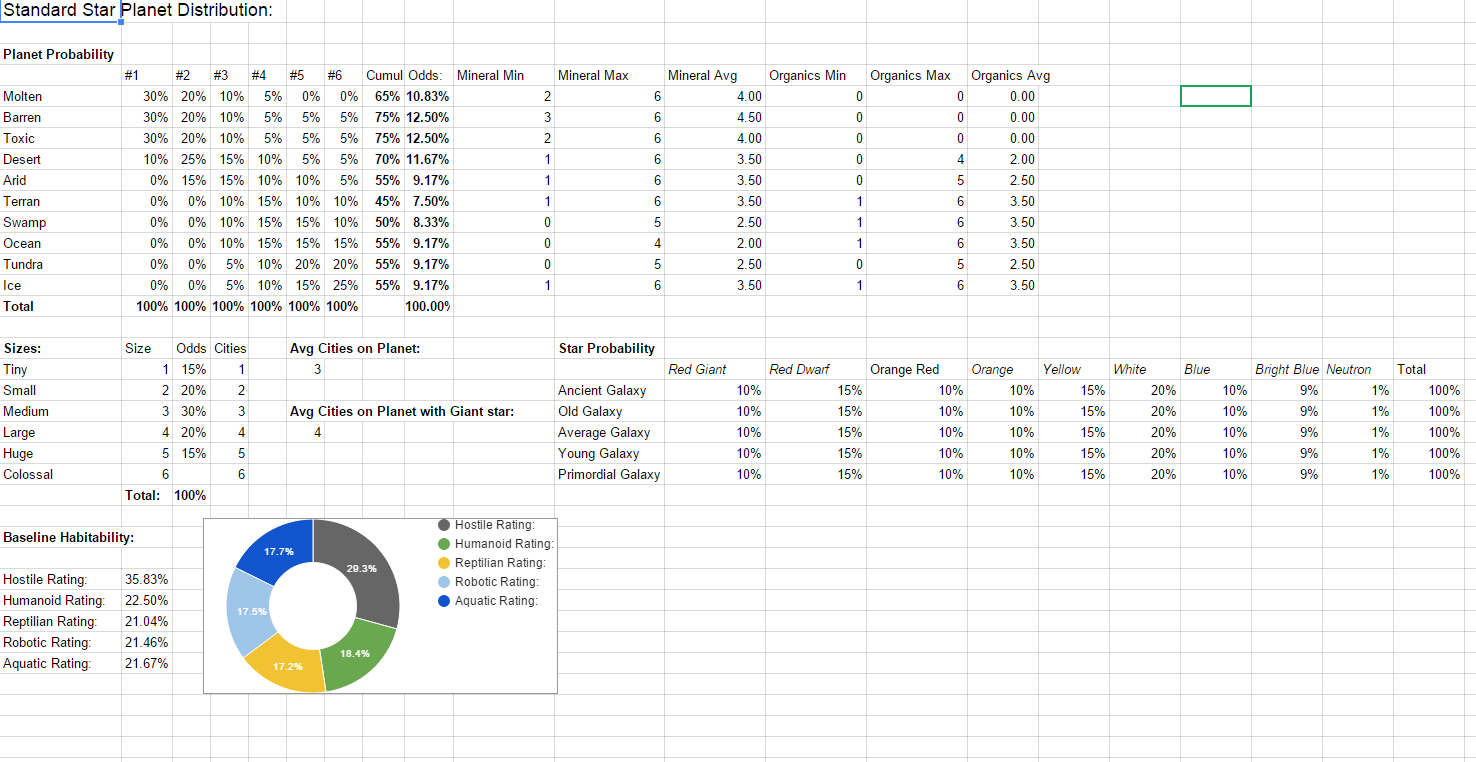
In our previous dev update, we added the Revenant faction and talked about Temporal Rifts that can open throughout the game and spit out Revenant ships to attack. This month we activated that feature and expanded on it with a whole series of new Temporal Rift events and and an entirely new Rift Investigation mechanic that spawns the rift inside fleet combat. As part of this system, we’ve re-activated the salvage gameplay on the Fleet Combat Victory Screen and added ship crew XP to this screen. We’ve also made a number of improvements and optimisations to the Galaxy generation code and galaxy graphics, and fixed a ton of bugs and crashes.
As expected, we lost some dev time recently due to boring but necessary parts of running a business such as putting together our corporation tax return and documentation for the British Film Institute to get the game accredited as a British video game. We also took a weekend out to attend the 2016 global game jam, which was a ton of fun! Now that we’re through all that, we’re ramping things up and moving on to develop victory conditions, the Revenant Planet event, the Synergies tech tree, and start on tech era 4. This will take us considerably closer to the big version 1.0 release, so we hope you like it and continue to follow our development this month.
Read on for a full breakdown of what we’ve added since the last dev update, and a preview of the victory conditions and other features we’re currently working on:

Back in the Fleet Combat modular tests, we had a salvage system where the winner of a battle could recover scrap from the field of battle. We’ve now re-implemented this system and improved it, and we’ve added in the crew XP system to this screen so you can see your ship captains and crew gaining XP and levelling up. When a ship or structure is blown up in fleet combat, it will be completely obliterated, disabled or shipwrecked. After each battle, the winner can salvage any ships that weren’t completely obliterated and can gain a number of things:
- Nothing (Common) – Often nothing is salvageable from a shipwreck.
- Money (Common) – A fraction of the BC cost of a ship can be recovered if any expensive components survive.
- Data Disk (Uncommon) – A data disk from the ship can sometimes survive, giving you bonus research points toward whatever you’re currently researching.
- Technology (Rare) – A weapon or ship module can sometimes survive the battle in-tact. Recovering it instantly grants you that technology if you don’t already have it, otherwise it will be salvaged into a Data Disk.
As part of this system, we’ve also added new graphics for disabled and wrecked ships both in the victory screen and the main fleet combat screen (see below). Disabled ships now show as having some of their parts smashed off and pointing in the wrong direction, while wrecked ships have some ship parts missing entirely. We did this by adding a pseudorandom factor to the position and rotation of ship parts when destroyed, so no new models needed to be created for destroyed ships, which is good for memory usage. At popular request from those who played the fleet combat modular test, we’ve also included a Salvage All button and a scroll bar.


As we explained in the previous devblog, Temporal Rifts open throughout the game and spit out ships, salvage and technology into the galaxy. You can send ships to investigate a rift and lay claim to whatever comes out, but it could be enemy ships or even deadly Revenant ships. We initially disabled this while coming up with a better algorithm for balancing Revenant attacks, and now that we’ve completed this we’ve activated rifts in the V0.9.1.0 patch. We’ve also added a bunch of new temporal rift events and an entirely new Temporal Rift Investigation system.
Rift Balance: Temporal Rifts now have a 5% chance to spawn each turn once you’ve reached the Space Exploration era, with a maximum of one every 20 turns and some tweaks to ensure they are distributed more evenly near each race’s planets. The Astronomical Survey tech now adds an additional 1% chance of temporal rifts spawning near your planets on top of the standard 5% per turn chance of one spawning anywhere in the game each turn, so your chance of getting a rift near your space rises by 20%. The Astronomical Research technology also now adds 2 bonus data disks to each Temporal Rift Investigation event, providing 25-50 research points each.
Rift Investigation: When you send ships to investigate a rift, it now spawns a Fleet Combat scenario filled with asteroids, nebular gas, ion storms, and one central temporal rift. The rift will open within 2-3 full fleet combat rounds, giving you very little time to get your ships in place to deal with whatever comes through. You can hide ships in the nebular gas to cloak them, for example, or move your ships to surround the rift. (See image below). Rift types are:
- Asteroids – Common rift that spawns a few asteroids in fleet combat and does nothing if not investigated.
- Nothing – Common rift that does nothing, but can be investigated for a little ship crew XP and sensor data.
- Commander – A rare rift that gives you a free Ship Captain or Planet Leader, who works for free!
- Unexploded Mine – A common rift that spits out an unexploded space mine that detonates 1 turn after the rift opens. If you’ve moved your ships in close, they’ll explode!
- Salvage – A common rift that spits out wrecked ships that can be salvaged for money, research points, and sometimes advanced technology you don’t have yet! If nobody sends ships to investigate these rifts, they don’t do anything and the salvage/technology is wasted.
- Friendly Ships – A rare rift that spits out friendly combat ships that immediately join your empire for free. The ships are always about the same tech level as you. If nobody investigates the rift, the ships will still spawn and will head to your empire when the rift closes.
- Enemy Ships – A rare rift that spits out ships belonging to another race in the game. If you destroy them, that race never finds out. If you let them go, they head to that race and join their empire.
- Computer Virus – A rare rift that releases a computer virus that infects your race’s research systems, destroying some of your current progress toward the next tech.
- Ancient Ruins – An extremely rare rift that adds 2 ancient ruins to a planet.
- Temporal Freeze – An extremely rare rift that locks a planet in a temporal bubble, freezing it in place for 10-20 turns.
- Temporal Acceleration – An extremely rare rift that speeds a planet up for 10-20 turns, causing it to take two turns each turn!
- Temporal Bubble – An extremely rare rift that fast-forwards a planet in time by 100,000 years. The Civilization is wiped out, but all cities on the planet to turn into clusters of ancient ruins.

.

In patch V0.9.0.6, we deployed a new planet balancing algorithm based on your feedback. Some players pointed out that stars could generate with illogical planet setups such as Red Giants with Ice planets right next to the star. We worked out a completely new map generation algorithm that will produce more realistic results and which has been designed with game balance in mind. Each planet type was given a habitability index for each race archetype (for example, Reptiles really like Desert planets), and that was used to work out balanced planet percentages. A spreadsheet with the new data and analysis can be found here. This will also allow us to work out different star probabilities for different galaxy ages in a future update while maintaining the game balance.
After overhauling planet distribution, we took the opportunity this month to improve the galaxy map a bit in V0.9.1.0. The biggest change here is a revamp of the galaxy generation algorithm that should make more playable maps and reduce the number of orphaned stars you can’t realistically reach. We now generate 13 points spread evenly across the map plane and several generations of stars spread out from these with a maximum of 50ly distance instead of being placed randomly throughout the game world. We’ve also removed the Stellar Gas selector and reduced the brightness of the stellar gas, as we found it washed out the graphics when zoomed in even a little. A list of the main galaxy changes is below:
- Star positions on a 3D map are now partially tested for proximity to other stars in 2D too, so they’ll be more separated apart when viewed from above. This means a top-down view is now good even on a 3D map as you’ll see less overlap. As a bonus, galaxies are now naturally a bit flatter in 3D so we no longer have to artificially flatten 3D maps, which produces more playable maps.
- 2D maps now display on a larger grid and are more spread out
- Homeworlds now generate up to three generations of stars spreading out from them before the random stars are added to fill in the gaps, and potential homeworld positions that are not selected as homeworlds still have stars spraw out from them. This gives every race a good start and makes the starting positions of each race less obvious.
- We’ve now balanced Large and Huge map generation mechanics. These are still disabled but should now be balanced for when we activate them
- We’ve added some more randomness to the race starting positions. Races can now start closer to the edge of the star cluster or the center. This means you might by chance start quite close to another race and make first contact earlier than usual.
- Nebulae can now spawn near homeworlds and engulf them. This is OK now because homeworlds are not regenerated by being in nebulae any more, but any nebula effects we add will be used in that star system so you could start with nebula effects in your starting system.
- The stellar gas colour selector has been removed as this only had a minor impact on gameplay and it so much compelling as confusing. The gas colour is now selected randomly, and gas is now less bright so that it isn’t so prominent when zoomed in.
- Older galaxies with fewer nebulae will now have bonus nebulae to maintain the chance of strategic resources spawning in the map.
- The nebula graphics have also been improved and darkened a bit and have been optimised a little for performance while we were at it.

.

In response to your feedback and some footage from let’s plays of Predestination, we tackled some problems with the Diplomacy AI in patch V0.9.0.6. The main change is that there is no longer any diminishing returns on diplomatic offers, as this often worked out to be quite confusing for people making offers in diplomacy. The scores the AI assigns to things like technologies and money have also been rebalanced, and the penalty for making an offensive offer have been reduced significantly as they were far too punishing. This is something we can potentially use in future for the harder difficulty modes. A full list of the improvements is below:
- The Diplomacy AI now scores technologies based on how much RP they cost compared to the other race’s top tech in that same field. If your top Biology tech is 720RP then a 720RP technology from the other race will score 100 points, a 360RP tech would score 50, and a 1440RP tech would score 200 points. This means you can pick up old techs you missed pretty easily from another race as they know they’re not going to give you a huge advantage, while technologies ahead of your level of technology will be very expensive.
- Technologies that the other race has already partly researched are only worth the value of the remaining RP when traded. You have no way of knowing what they’re researching currently, but we could add this as a feature for the Scientific Advisor report.
- Diminishing returns on diplomatic offer scores has been removed. Now every item in the list will count 100% toward the offer.
- In diplomatic trades, money is now scored with a new formula based on the amount of money the race has and how much it generates each turn. This better represents how valuable that money is to the race receiving it.
- When adding money to either side of a diplomatic trade, the counter now increments in increments of 10 instead of 1. Once it hits 1000, it begins counting in increments of 100 as before.
- You can now demand a maximum of 2,000 BC from the AI during any session of diplomacy. In practice, it’s impossible to actually get that much off them unless you are rolling in so much money that it won’t make a difference.
- The favour penalties for proposing bad deals have been reduced. They are now 2% of the difference in value of the deals for a standard rejection and 5% for an offended rejection. This compensates for the fact that we are now sometimes dealing with larger valuation scores for diplomatic offers.
- The AI will no longer accept a deal that it has previously rejected during the same diplomacy session. Previously you could propose the same deal repeatedly if it wasn’t accepted and the AI would sometimes change its mind.
.

The next big update is V0.9.2.0, which will introduce victory conditions for the sandbox game mode (the mode you can currently play) as well as the Revenant Planet decloaking event, the Synergies tech tree, and the start of Tech Era 4. Each victory condition will have its own ending scene explaining what happened after you won, which will be different depending on whether the Revenants have awoken in your game. The victory conditions we’re planning to have are:
- Galactic Domination: Defeat all the other races in the game. If the Revenant planet decloaks during the game, this victory condition will no longer be possible and you’ll need to defeat the Revenants.
- Destroy Revenants: Find and destroy the Revenant Planet. At some point during the game, the Revenant planet will decloak somewhere on the map and they’ll begin attacking other races at random. If you can conquer their planet, you get access to their advanced technologies and your dominance of the galaxy is assured.
- Technological: Research technologies to stop the Revenants. You’ll need to research technologies from the end of each technology tree, which will unlock a series of technologies in the Synergies screen that will all form part of a plan to defeat the Revenants. This goal can be completed even if the Revenants are awake.
- Diplomacy: Unite the Galaxy in enduring, peaceful alliance. This will be based on the duration of the alliance, and you’ll get notifications about this victory condition as you get closer to this goal. It will end with you being voted leader of a new galactic empire, which you can accept to win the game or reject to continue if you want to pursue another victory condition. This goal can be completed even if the Revenants are awake.
Revenant Decloak Event:
As you’ve been sent back in time, the Revenant planet is still waiting somewhere in your galaxy to be found. They can be deliberately awoken by a ship with Temporal Sensors (from tech era 4) finding the right star system, or accidentally awoken by a signal coming from a temporal rift. The rift will be rare and will trigger only when the game has reached the late stage where at least one race is researching endgame technologies. Once the Revenant planet is decloaked, ships will emerge every few turns and head to a random colonised planet to attack. The planet itself will have significant defenses and powerful ships if you choose to attack it.
Synergies Tech Tree:
You may have spotted the Synergies tech tree that is currently grayed out. This tree will contain special bonus technologies that you can unlock by combining combinations of technologies in other fields. For example, if you research Augmented Engines and Fighter Garrison, you might unlock a Fighter Engine Augmentation technology that improves the speed of all fighters. This tree will also contain small improvements on existing technologies, so you might research Fusion Beam and have to choose between improving its Damage, Range, or Firing Arc. These improvements could also be traded with other races and Creative races like the United Colonies can research multiple improvements. This tree is also where you’ll find the Technological Victory win condition.
Tech Era 4: Galactic Domination:
In order to implement the Technological Victory victory condition, we need to implement the game’s fourth tech era. We’ll be adding this era with mostly blank technologies and filling in a few early ones that make sense if we get time. We may also go back and edit Tech Era 3 to make technologies fit or add extra technologies that we think players should get access to earlier. Tech Era 4 will be focused on military warfare, ship designs and advanced diplomacy rather than planet, buildings and exploration. Expect more weapons, modules, base armour, shields, and other military techs in this era.
.
A big thanks to everyone for reading this massive development update, and a special thanks to all of our new players who bought into the Early Access over the recent Steam sales, and everyone who has been putting in bug and crash reports and leaving reviews for the game on Steam. As always, please feel free to give us any feedback you have on this month’s dev update either here or on the Steam forum, or you can send your feedback directly to us in private by emailing it to brendan@brainandnerd.com . If you’re a backer and don’t have access to the Early Access yet, please mail earlyaccessrequest@brainandnerd.com and we’ll send you out your key.
Cheers,
— Brendan, Lead Developer






